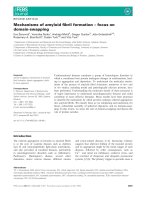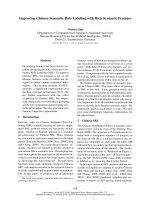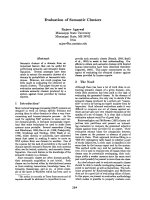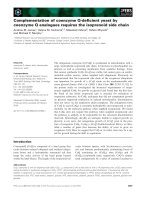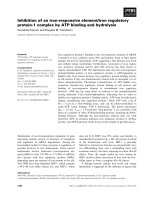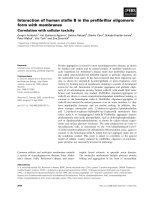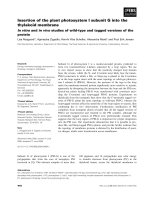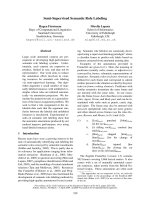Báo cáo khoa học: "Framework of Semantic Role Assignment based on Extended Lexical Conceptual Structure: Comparison with VerbNet and FrameNet" ppt
Bạn đang xem bản rút gọn của tài liệu. Xem và tải ngay bản đầy đủ của tài liệu tại đây (520.64 KB, 10 trang )
Proceedings of the 13th Conference of the European Chapter of the Association for Computational Linguistics, pages 686–695,
Avignon, France, April 23 - 27 2012.
c
2012 Association for Computational Linguistics
Framework of Semantic Role Assignment based on Extended Lexical
Conceptual Structure: Comparison with VerbNet and FrameNet
Yuichiroh Matsubayashi
†
Yusuke Miyao
†
Akiko Aizawa
†
†
, National Institute of Informatics, Japan
{y-matsu,yusuke,aizawa}@nii.ac.jp
Abstract
Widely accepted resources for semantic
parsing, such as PropBank and FrameNet,
are not perfect as a semantic role label-
ing framework. Their semantic roles are
not strictly defined; therefore, their mean-
ings and semantic characteristics are un-
clear. In addition, it is presupposed that
a single semantic role is assigned to each
syntactic argument. This is not necessarily
true when we consider internal structures of
verb semantics. We propose a new frame-
work for semantic role annotation which
solves these problems by extending the the-
ory of lexical conceptual structure (LCS).
By comparing our framework with that of
existing resources, including VerbNet and
FrameNet, we demonstrate that our ex-
tended LCS framework can give a formal
definition of semantic role labels, and that
multiple roles of arguments can be repre-
sented strictly and naturally.
1 Introduction
Recent developments of large semantic resources
have accelerated empirical research on seman-
tic processing (M
`
arquez et al., 2008). Specif-
ically, corpora with semantic role annotations,
such as PropBank (Kingsbury and Palmer, 2002)
and FrameNet (Ruppenhofer et al., 2006), are in-
dispensable resources for semantic role labeling.
However, there are two topics we have to carefully
take into consideration regarding role assignment
frameworks: (1) clarity of semantic role meanings
and (2) the constraint that a single semantic role
is assigned to each syntactic argument.
While these resources are undoubtedly invalu-
able for empirical research on semantic process-
Sentence [John] threw [a ball] [from the window] .
Affection Agent Patient
Movement Source Theme Source/Path
PropBank Arg0 Arg1 Arg2
VerbNet Agent Theme Source
FrameNet Agent Theme Source
Table 1: Examples of single role assignments with ex-
isting resources.
ing, current usage of semantic labels for SRL sys-
tems is questionable from a theoretical viewpoint.
For example, most of the works on SRL have
used PropBank’s numerical role labels (Arg0 to
Arg5). However, the meanings of these numbers
depend on each verb in principle and PropBank
does not expect semantic consistency, namely on
Arg2 to Arg5. Moreover, Yi et al. (2007) explic-
itly showed that Arg2 to Arg5 are semantically
inconsistent. The reason why such labels have
been used in SRL systems is that verb-specific
roles generally have a small number of instances
and are not suitable for learning. However, it is
necessary to avoid using inconsistent labels since
those labels confuse machine learners and can be
a cause of low accuracy in automatic process-
ing. In addition, clarity of the definition of roles
are particularly important for users to rationally
know how to use each role in their applications.
For this reasons, well-organized and generalized
labels grounded in linguistic characteristics are
needed in practice. Semantic roles of FrameNet
and VerbNet (Kipper et al., 2000) are used more
consistently to some extent, but the definition of
the roles is not given in a formal manner and their
semantic characteristics are unclear.
Another somewhat related problem of existing
annotation frameworks is that it is presupposed
686
that a single semantic role is assigned to each syn-
tactic argument.
1
In fact, one syntactic argument
can play multiple roles in the event (or events) ex-
pressed by a verb. For example, Table 1 shows a
sentence containing the verb “throw” and seman-
tic roles assigned to its arguments in each frame-
work. The table shows that each framework as-
signs a single role, such as Arg0 and Agent, to
each syntactic argument. However, we can ac-
quire information from this sentence that John
is an agent of the throwing event (the “Affec-
tion” row), as well as a source of the movement
event of the ball (the “Movement” row). Existing
frameworks of assigning single roles simply ig-
nore such information that verbs inherently have
in their semantics. We believe that giving a clear
definition of multiple argument roles would be
beneficial not only as a theoretical framework but
also for practical applications that require detailed
meanings derived from secondary roles.
This issue is also related to fragmentation and
the unclear definition of semantic roles in these
frameworks. As we exemplify in this paper, mul-
tiple semantic characteristics are conflated in a
single role label in these resources due to the man-
ner of single-role assignment. This means that se-
mantic roles of existing resources are not mono-
lithic and inherently not mutually independent,
but they share some semantic characteristics.
The aim of this paper is more on theoreti-
cal discussion for role-labeling frameworks rather
than introducing a new resource. We developed
a framework of verb lexical semantics, which is
an extension of the lexical conceptual structure
(LCS) theory, and compare it with other exist-
ing frameworks which are used in VerbNet and
FrameNet, as an annotation scheme of SRL. LCS
is a decomposition-based approach to verb se-
mantics and describes a meaning by composing
a set of primitive predicates. The advantage of
this approach is that primitive predicates and their
compositions are formally defined. As a result,
we can give a strict definition of semantic roles
by grounding them to lexical semantic structures
of verbs. In fact, we define semantic roles as ar-
gument slots in primitive predicates. With this ap-
1
To be precise, FrameNet permits multiple-role assign-
ment, while it does not perform this systematically as we
show in Table 1. It mostly defines a single role label for a
corresponding syntactic argument, that plays multiple roles
in several sub-events in a verb.
proach, we demonstrate that some sort of seman-
tic characteristics that VerbNet and FrameNet in-
formally/implicitly describe in their roles can be
given formal definitions and that multiple argu-
ment roles can be represented strictly and natu-
rally by extending the LCS theory.
In the first half of this paper, we define our ex-
tended LCS framework and describe how it gives
a formal definition of roles and solves the problem
of multiple roles. In the latter half, we discuss
the analysis of the empirical data we collected
for 60 Japanese verbs and also discuss theoreti-
cal relationships with the frameworks of existing
resources. We discuss in detail the relationships
between our role labels and VerbNet’s thematic
roles. We also describe the relationship between
our framework and FrameNet, with regards to the
definitions of the relationships between semantic
frames.
2 Related works
There have been several attempts in linguistics
to assign multiple semantic properties to one ar-
gument. Gruber (1965) demonstrated the dis-
pensability of the constraint that an argument
takes only one semantic role, with some concrete
examples. Rozwadowska (1988) suggested an
approach of feature decomposition for semantic
roles using her three features of change, cause,
and sentient, and defined typical thematic roles
by combining these features. This approach made
it possible for us to classify semantic properties
across thematic roles. However, Levin and Rap-
paport Hovav (2005) argued that the number of
combinations using defined features is usually
larger than the actual number of possible com-
binations; therefore, feature decomposition ap-
proaches should predict possible feature combi-
nations.
Culicover and Wilkins (1984) divided their
roles into two groups, action and perceptional
roles, and explained that dual assignment of roles
always involves one role from each set. Jackend-
off (1990) proposed an LCS framework for rep-
resenting the meaning of a verb by using several
primitive predicates. Jackendoff also stated that
an LCS represents two tiers in its structure, action
tier and thematic tier, which are similar to Culi-
cover and Wilkins’s two sets. Essentially, these
two approaches distinguished roles related to ac-
tion and change, and successfully restricted com-
687
2
6
6
4
cause(affect(i,j), go(j,
2
6
4
from(locate(in(i)))
fromward(locate(at(k)))
toward(locate(at(l)))
3
7
5
))
3
7
7
5
Figure 1: LCS of the verb throw.
binations of roles by taking a role from each set.
Dorr (1997) created an LCS-based lexical re-
source as an interlingual representation for ma-
chine translation. This framework was also used
for text generation (Habash et al., 2003). How-
ever, the problem of multiple-role assignment was
not completely solved on the resource. As a
comparison of different semantic structures, Dorr
(2001) and Haji
ˇ
cov
´
a and Ku
ˇ
cerov
´
a (2002) ana-
lyzed the connection between LCS and PropBank
roles, and showed that the mapping between LCS
and PropBank roles was many to many correspon-
dence and roles can map only by comparing a
whole argument structure of a verb. Habash and
Dorr (2001) tried to map LCS structures into the-
matic roles by using their thematic hierarchy.
3 Multiple role expression using lexical
conceptual structure
Lexical conceptual structure is an approach to de-
scribe a generalized structure of an event or state
represented by a verb. A meaning of a verb is rep-
resented as a structure composed of several prim-
itive predicates. For example, the LCS structure
for the verb “throw” is shown in Figure 1 and
includes the predicates cause, affect, go, from,
fromward, toward, locate, in, and at. The argu-
ments of primitive predicates are filled by core ar-
guments of the verb. This type of decomposition
approach enables us to represent a case that one
syntactic argument fills multiple slots in the struc-
ture. In Figure 1, the argument i appears twice in
the structure: as the first argument of affect and
the argument in from.
The primitives are designed to represent a full
or partial action-change-state chain, which con-
sists of a state, a change in or maintaining of a
state, or an action that changes/maintains a state.
Table 2 shows primitives that play important roles
to represent that chain. Some primitives embed
other primitives as their arguments and the seman-
tics of the entire structure of an LCS structure
is calculated according to the definition of each
primitive. For instance, the LCS structure in Fig-
Predicates Semantic Functions
state(x, y) First argument is in state specified by
second argument.
cause(x, y) Action in first argument causes change
specified in second argument.
act(x) First argument affects itself.
affect(x, y) First argument affects second argument.
react(x, y) First argument affects itself, due to the
effect from second argument.
go(x, y) First argument changes according to the
path described in the second argument.
from(x) Starting point of certain change event.
fromward(x) Direction of starting point.
via(x) Pass point of certain change event.
toward(x) Direction of end point.
to(x) End point of certain change event.
along(x) Linear-shaped path of change event.
Table 2: Major primitive predicates and their semantic
functions.
ure 1 represents the action changing the state of j.
The inner structure of the second argument of go
represents the path of the change.
The overall definition of our extended LCS
framework is shown in Figure 2.
2
Basically, our
definition is based on Jackendoff’s LCS frame-
work (1990), but performed some simplifications
and added extensions. The modification is per-
formed in order to increase strictness and gen-
erality of representation and also a coverage for
various verbs appearing in a corpus. The main
differences between the two LCS frameworks are
as follows. In our extended LCS framework, (i)
the possible combinations of cause, act, affect,
react, and go are clearly restricted, (ii) multiple
actions or changes in an event can be described
by introducing a combination function (comb for
short), (iii) GO, STAY and INCH in Jackendoff’s
theory are incorporated into one function go, and
(iv) most of the change-of-state events are repre-
sented as a metaphor using a spatial transition.
The idea of a comb function comes from a nat-
ural extension of Jackendoff’s EXCH function.
In our case, comb is not limited to describing
a counter-transfer of the main event but can de-
scribe subordinate events occurring in relation to
the main event.
3
We can also describe multiple
2
Here we omitted the attributes taken by each predicate,
in order to simplify the explanation. We also omitted an
explanation for lower level primitives, such as STATE and
PLACE groups, which are not necessarily important for the
topic of this paper.
3
In our extended LCS theory, we can describe multiple
688
LCS =
2
4
EVENT+
comb
h
EVENT
i
*
3
5
STATE =
8
>
>
>
>
>
<
>
>
>
>
>
:
be
locate(PLACE)
orient(PLACE)
extent(PLACE)
connect(arg)
9
>
>
>
>
>
=
>
>
>
>
>
;
EVENT =
2
6
6
6
6
6
6
6
6
6
6
6
6
6
6
6
6
4
8
>
>
>
>
>
<
>
>
>
>
>
:
state(arg, STATE)
go(arg, PATH)
cause(act(arg1), go(arg1, PATH))
cause(affect(arg1, arg2), go(arg2, PATH))
cause(react(arg1, arg2), go(arg1, PATH))
9
>
>
>
>
>
=
>
>
>
>
>
;
manner(constant)?
mean(constant)?
instrument(constant)?
purpose(EVENT)*
3
7
7
7
7
7
7
7
7
7
7
7
7
7
7
7
7
5
PLACE =
8
>
>
>
>
>
>
>
>
>
>
>
>
>
>
>
>
>
<
>
>
>
>
>
>
>
>
>
>
>
>
>
>
>
>
>
:
in(arg)
on(arg)
cover(arg)
fit(arg)
inscribed(arg)
beside(arg)
around(arg)
near(arg)
inside(arg)
at(arg)
9
>
>
>
>
>
>
>
>
>
>
>
>
>
>
>
>
>
=
>
>
>
>
>
>
>
>
>
>
>
>
>
>
>
>
>
;
PATH=
2
6
6
6
6
6
6
6
6
4
from(STATE)?
fromward(STATE)?
via(STATE)?
toward(STATE)?
to(STATE)?
along(arg)?
3
7
7
7
7
7
7
7
7
5
Figure 2: Description system of our LCS. Operators
+, ∗, ? follow the basic regular expression syntax. {}
represents a choice of the elements.
main events if the agent does more than two ac-
tions simultaneously and all the actions are the
focus (e.g., John exchanges A with B). This ex-
tension is simple, but essential for creating LCS
structures of predicates appearing in actual data.
In our development of 60 Japanese predicates
(verb and verbal noun) frequently appearing in
Kyoto University Text Corpus (KTC) (Kurohashi
and Nagao, 1997) , 37.6% of the frames included
multiple events. By using the comb function, we
can express complicated events with predicate de-
composition and prevent missing (multiple) roles.
A key point for associating LCS framework
with the existing frameworks of semantic roles is
that each primitive predicate of LCS represents
a fundamental function in semantics. The func-
events in the semantic structure of a verb. However, gener-
ally, a verb focuses on one of those events and this makes
a semantic variation among verbs such as buy, sell, and pay
as well as difference of syntactic behavior of the arguments.
Therefore, focused event should be distinguished from the
others as lexical information. We expressed focused events
as main formulae (formulae that are not surrounded by a
comb function).
Role Description
Protagonist Entity which is viewpoint of verb.
Theme Entity in which its state or change of state
is mentioned.
State Current state of certain entity.
Actor Entity which performs action that
changes/maintains its state.
Effector Entity which performs action that
changes/maintains a state of another entity.
Patient Entity which is changed/maintained its
state by another entity.
Stimulus Entity which is cause of the action.
Source Starting point of certain change event.
Source dir Direction of starting point.
Middle Pass point of certain change event.
Goal End point of certain change event.
Goal dir Direction of end point.
Route Linear-shaped path of certain change event.
Table3: Semantic role list for proposing extended LCS
framework.
tions of the arguments of the primitive predicates
can be explained using generalized semantic roles
such as typical thematic roles. In order to sim-
ply represent the semantic functions of the ar-
guments in the LCS primitives or make it eas-
ier to compare our extended LCS framework with
other SRL frameworks, we define a semantic role
set that corresponds to the semantic functions of
the primitive predicates in the LCS structure (Ta-
ble 3). We employed role names similarly to typ-
ical thematic roles in order to easily compare the
role sets, but the definition is different. Also, due
to the increase of the generality of LCS represen-
tation, we obtained clearer definition to explain a
correspondence between LCS primitives and typ-
ical thematic roles than the Jackendoff’s predi-
cates. Note that the core semantic information of
a verb represented by a LCS framework is em-
bodied directly in its LCS structure and the in-
formation decreases if the structure is mapped to
the semantic roles. The mapping is just for con-
trasting thematic roles. Each role is given an ob-
vious meaning and designed to fit to the upper-
level primitives of the LCS structure, which are
the arguments of EVENT and PATH functions. In
Table 4, we can see that these roles correspond al-
most one-to-one to the primitive arguments. One
special role is Protagonist, which does not match
an argument of a specific primitive. The Pro-
tagonist is assigned to the first argument in the
main formula to distinguish that formula from the
sub formulae. There are 13 defined roles, and
689
Predicate 1st arg 2nd arg
state Theme State
act Actor –
affect Effector Patient
react Actor Stimulus
go Theme PATH
from Source –
fromward Source dir –
via Middle –
toward Goal dir –
to Goal –
along Route –
Table 4: Correspondence between semantic roles and
arguments of LCS primitives
this number is comparatively smaller than that in
VerbNet. The discussion with regard to this num-
ber is described in the next section.
Essentially, the semantic functions of the ar-
guments in LCS primitives are similar to those
of traditional, or basic, thematic roles. However,
there are two important differences. Our extended
LCS framework principally guarantees that the
primitive predicates do not contain any informa-
tion concerning (i) selectional preference and (ii)
complex structural relation of arguments. Primi-
tives are designed to purely represent a function
in an action-change-state chain, thus the informa-
tion of selectional preference is annotated to a dif-
ferent layer; specifically, it is directly annotated to
core arguments (e.g., we can annotate i with sel-
Pref(animate ∨ organization) in Figure 1). Also,
the semantic function is already decomposed and
the structural relation among the arguments is rep-
resented as a structure of primitives in LCS rep-
resentation. Therefore, each argument slot of
the primitive predicates does not include compli-
cated meanings and represents a primitive seman-
tic property which is highly functional. These
characteristics are necessary to ensure clarity of
the semantic role meanings. We believe that even
though there surely exists a certain type of com-
plex semantic role, it is reasonable to represent
that role based on decomposed properties.
In order to show an instance of our extended
LCS theory, we constructed a dictionary of LCS
structures for 60 Japanese verbs (including event
nouns) using our extended LCS framework. The
60 verbs were the most frequent verbs in KTC af-
ter excluding 100 most frequent ones.
4
We cre-
4
We omitted top 100 verbs since these most frequent ones
Role Single Multiple Grow (%)
Theme 21 108 414
State 1 1 0
Actor 12 13 8.3
Effector 73 92 26
Patient 77 79 2.5
Stimulus 0 0 0
Source 11 44 300
Source dir 4 4 0
Middle 1 8 700
Goal 42 81 93
Goal dir 2 3 50
Route 2 2 0
w/o Theme 225 327 45
Total 246 435 77
Table 5: Number of appearances of each role
ated the dictionary looking at the instances of
the target verbs in KTC. To increase the cover-
age of senses and case frames, we also consulted
the online Japanese dictionary Digital Daijisen
5
and Kyoto university case frames (Kawahara and
Kurohashi, 2006) which is a compilation of case
frames automatically acquired from a huge web
corpus. There were 97 constructed frames in the
dictionary.
Then we analyzed how many roles are addi-
tionally assigned by permitting multiple role as-
signment (see Table 5). The numbers of assigned
roles for single role are calculated by counting
roles that appear first for each target argument in
the structure. Table 5 shows that the total number
of assigned roles is 1.77 times larger than single-
role assignment. The main reason is an increase in
Theme. For single-role assignment, Theme, in our
sense, in action verbs is always duplicated with
Actor/Patient. On the other hand, LCS strictly
divides a function for action and change; there-
fore the duplicated Theme is correctly annotated.
Moreover, we obtained a 45% increase even when
we did not count duplicated Theme. Most of in-
crease are a result from the increase in Source
and Goal. For example, Effectors of transmission
verbs are also annotated with a Source, and Effec-
tors of movement verbs are sometimes annotated
with Source or Goal.
contain a phonogram form (Hiragana form) of a certain verb
written with Kanji characters, and that phonogram form gen-
erally has a huge ambiguity because many different verbs
have same pronunciation in Japanese.
5
Available at />690
Resource Frame-independent # of roles
LCS yes 13
VerbNet (v3.1) yes 30
FrameNet (r1.4) no 8884
Table 6: Number of roles in each resource.
4 Comparison with other resources
4.1 Number of semantic roles
The number of roles is related to the number of se-
mantic properties represented in a framework and
to the generality of that property. Table 6 lists the
number of semantic roles defined in our extended
LCS framework, VerbNet and FrameNet.
There are two ways to define semantic roles.
One is frame specific, where the definition of each
role depends on a specific lexical entry and such
a role is never used in the other frames. The other
is frame independent, which is to construct roles
whose semantic function is generalized across
all verbs. The number of roles in FrameNet is
comparatively large because it defines roles in a
frame-specific way. FrameNet respects individual
meanings of arguments rather than generality of
roles.
Compared with VerbNet, the number of roles
defined in our extended LCS framework is less
than half. However, this fact does not mean
that the representation ability of our framework is
lower than VerbNet. We manually checked and
listed a corresponding representation in our ex-
tended LCS framework for each thematic role in
VerbNet in Table 6. This table does not provide a
perfect or complete mapping between the roles in
these two frameworks because the mappings are
not based on annotated data. However, we can
roughly say that the VerbNet roles combine three
types of information, a function of the argument
in the action-change-state chain, selectional pref-
erence, and structural information of arguments,
which are in different layers in LCS representa-
tion. VerbNet has many roles whose functions in
the action-change-state chain are duplicated. For
example, Destination, Recipient, and Beneficiary
have the same property end-state (Goal in LCS)
of a changing event. The difference between such
roles comes from a specific sub-type of a chang-
ing event (possession), selectional preference, and
structural information among the arguments. By
distinguishing such roles, VerbNet roles may take
into account specific syntactic behaviors of cer-
tain semantic roles. Packing such complex infor-
mation to semantic roles is useful for analyzing
argument realization. However, from the view-
point of semantic representation, the clarity for
semantic properties provided using a predicate de-
composition approach is beneficial. The 13 roles
for the LCS approach is sufficient for obtaining
a function in the action-change-state chain. In
our LCS framework, selectional preference can
be assigned to arguments in an individual verb or
verb class level instead of role labels themselves
to maintain generality of semantic functions. In
addition, our extended LCS framework can easily
separate complex structural information from role
labels because LCS directly represents a structure
among the arguments. We can calculate the infor-
mation from the LCS structure instead of coding
it into role labels. As a result, our extended LCS
framework maintains generality of roles and the
number of roles is smaller than other frameworks.
4.2 Clarity of role meanings
We showed that an approach of predicate decom-
position used in LCS theory clarified role mean-
ings assigned to syntactic arguments. Moreover,
LCS achieves high generality of roles by separat-
ing selectional preference or structural informa-
tion from role labels. The complex meaning of
one syntactic argument is represented by multi-
ple appearances of the argument in an LCS struc-
ture. For example, we show an LCS structure
and a frame in VerbNet with regard to the verb
“buy” in Figure 3. The LCS structure consists
of four formulae. The first one is the main for-
mula and the others are sub-formulae that rep-
resent co-occurring actions. The semantic-role-
like representation of the structure is given in Ta-
ble 4: i = {Protagonist, Effector, Source, Goal},
j = {Patient, Theme}, k = {Effector, Source,
Goal}, and l = {Patient, Theme}. Selectional
preference is annotated to each argument as i:
selPref(animate ∨ organization), j: selPref(any),
k: selPref(animate ∨ organization), and l: sel-
Pref(valuable entity). If we want to represent the
information, such as “Source of what?”, then we
can extend the notation as Source(j) to refer to a
changing object.
On the other hand, VerbNet combines mul-
tiple types of information into a single role as
mentioned above. Also, the meaning of some
691
VerbNet role (# of uses) Representation in LCS
Actor (9), Actor1 (9), Actor2 (9) Actor or Effector in symmetric formulas in the structure
Agent (212) (Actor ∨ Effector) ∧ Protagonist
Asset (6) Theme ∧ Source of the change is (locate(in()) ∧ Protagonist) ∧
selPref(valuable entity)
Beneficiary (9) (peripheral role ∨ (Goal ∧ locate(in()))) ∧ selPref(animate ∨ organization)
∧ ¬(Actor ∨ Effector) ∧ a transferred entity is something beneficial
Cause (21) ((Effector ∧ selPref(¬animate ∧ ¬organization)) ∨ Stimulus ∨ peripheral role)
Destination (32) Goal
Experiencer (24) Actor of react()
Instrument (25) ((Effector ∧ selPref(¬animate ∧ ¬organization)) ∨ peripheral role)
Location (45) (Theme ∨ PATH roles ∨ peripheral role) ∧ selPref(location)
Material (6) Theme ∨ Source of a change ∧ The Goal of the change is locate(fit()) ∧
the Goal fullfills selPref(physical object)
Patient (59), Patient 1(11) Patient ∨ Theme
Patient2 (11) (Source ∨ Goal) ∧ connect()
Predicate (23) Theme ∨ (Goal ∧ locate(fit())) ∨ peripheral role
Product (7) Theme ∨ (Goal ∧ locate(fit()) ∧ selPref(physical object))
Proposition (11) Theme
Recipient (33) Goal ∧ locate(in()) ∧ selPref(animate ∨ organization)
Source (34) Source
Theme (162) Theme
Theme1 (13), Theme2 (13) Both of the two is Theme ∨ Theme1 is Theme and Theme2 is State
Topic (18) Theme ∧ selPref(knowledge ∨ infromation)
Table 7: Relationship of roles between VerbNet and our LCS framework. VerbNet roles that appears more than
five times in frame definition are analyzed. Each relationship shown here is only a partial and consistent part of
the complete correspondence table. Note that complete table of mapping highly depends on each lexical entry
(or verb class). Here, locate(in()) generally means possession or recognizing.
roles depends more on selectional preference or
the structure of the arguments than a primitive
function in the action-change-state chain. Such
VerbNet roles are used for several different func-
tions depending on verbs and their alternations,
and it is therefore difficult to capture decomposed
properties from the role label without having spe-
cific lexical knowledge. Moreover, some seman-
tic functions, such as Mary is a Goal of the money
in Figure 3, are completely discarded from the
representation at the level of role labels.
There is another representation related to the
argument meanings in VerbNet. This representa-
tion is a type of predicate decomposition using its
original set of predicates, which are referred to as
semantic predicates. For example, the verb “buy”
in Figure 3 has the predicates has possession,
transfer and cost for composing the meaning of
its event structure. The thematic roles are fillers
of the predicates’ arguments, thus the semantic
predicates may implicitly provide additional func-
tions to the roles and possibly represent multiple
roles. Unfortunately, we cannot discover what
each argument of the semantic predicates exactly
means since the definition of each predicate is not
Example: “John bought a book from Mary for $10.”
VerbNet: Agent V Theme {from} Source {for} Asset.
has possession(start(E), Source, Theme),
has possession(end(E), Agent, Theme),
transfer(during(E), Theme), cost(E, Asset)
LCS:
2
6
6
6
6
6
6
6
6
6
6
6
6
6
6
6
4
cause(aff(i:John, j:a book), go(j,
h
to(loc(in(i)))
i
))
comb
2
4
cause(aff(i,l:$10), go(l,
"
from(loc(in(i)))
to(loc(at(k:Mary)))
#
))
3
5
comb
2
4
cause(aff(k,j), go(j,
"
from(loc(in(k)))
to(loc(at(i)))
#
))
3
5
comb
»
cause(aff(k,l), go(l,
h
to(loc(in(k)))
i
))
–
3
7
7
7
7
7
7
7
7
7
7
7
7
7
7
7
5
Figure 3: Comparison between the semantic predicate
representation and the LCS structure of the verb buy.
publicly available. A requirement for obtaining
implicit semantic functions from these semantic
predicates is clearly defining how the roles (or
functions) are calculated from these complex re-
lations of semantic predicates.
FrameNet does not use semantic roles general-
ized among all verbs or does not represent seman-
692
i: selPref(animate ∨ organization), j: selPref(any), k: selPref(animate ∨ organization), l:
selPref(valuable entity)
Figure 4: LCS of the verbs get, buy, sell, pay, and collect and their relationships calculated from the structures.
tic properties of roles using a predicate decom-
position approach, but defines specific roles for
each conceptual event/state to represent a specific
background of the roles in the event/state. How-
ever, at the same time, FrameNet defines several
types of parent-child relations between most of
the frames and between their roles; therefore, we
may say FrameNet implicitly describes a sort of
decomposed property using roles in highly gen-
eral or abstract frames and represents the inher-
itance of these semantic properties. One advan-
tage of this approach is that the inheritance of a
meaning between roles is controlled through the
relations, which are carefully maintained by hu-
man efforts, and is not restricted by the represen-
tation ability of the decomposition system. On the
other hand, the only way to represent generalized
properties of a certain semantic role is enumerat-
ing all inherited roles by tracing ancestors. Also,
a semantic relation between arguments in a cer-
tain frame, which is given by LCS structure and
semantic predicates of VerbNet, is only defined
by a natural language description for each frame
in FrameNet. From a CL point of view, we con-
sider that, at least, a certain level of formalization
of semantic relation of arguments is important for
utilize this information for application. LCS ap-
proach, or an approach using a well-defined pred-
icate decomposition, can explicitly describe se-
mantic properties and relationships between argu-
Figure 5: The frame relations among the verbs get,
buy, sell, pay, and collect in FrameNet.
ments in a lexical structure. The primitive proper-
ties can be clearly defined, even though the repre-
sentation ability is restricted under the generality
of roles.
In addition, the frame-to-frame relations in
FrameNet may be a useful resource for some ap-
plication tasks such as paraphrasing and entail-
ment. We argue that some types of relationships
between frames are automatically calculated us-
ing the LCS approach. For example, one of the
relations is based on an inclusion relation of two
LCS structures. Figure 4 shows automatically
calculated relations surrounding the verb “buy”.
Note that we chose a sense related to a com-
mercial transaction, which means a exchange of
a goods and money, for each word in order to
compare the resulted relation graph with that of
FrameNet. We call relations among “buy”, “sell”,
“pay” and “collect” as different viewpoints since
693
they contain exactly the same formulae, and the
only difference is the main formula. The rela-
tion between “buy” and “get” is defined as in-
heritance; a part of the child structure exactly
equals the parent structure. Interestingly, the re-
lations surrounding the “buy” are similar to those
in FrameNet (see Figure 5). We cannot describe
all types of the relations we considered due to
space limitations. However, the point is that these
relationships are represented as rewriting rules
between the two LCS representations and thus
they are automatically calculated. Moreover, the
grounds for relations maintain clarity based on
concrete structural relations. A semantic relation
construction of frames based on structural rela-
tionships is another possible application of LCS
approaches that connects traditional LCS theo-
ries with resources representing a lexical network
such as FrameNet.
4.3 Consistency on semantic structures
Constructing a LCS dictionary is generally a dif-
ficult work since LCS has a high flexibility for
describing structures and different people tend to
write different structures for a single verb. We
maintained consistency of the dictionary by tak-
ing into account a similarity of the structures be-
tween the verbs that are in paraphrasing or entail-
ment relations. This idea was inspired by auto-
matic calculation of semantic relations of lexicon
as we mentioned above. We created a LCS struc-
ture for each lexical entry as we can calculate se-
mantic relations between related verbs and main-
tained high-level consistency among the verbs.
Using our extended LCS theory, we success-
fully created 97 frames for 60 predicates without
any extra modification. From this result, we be-
lieve that our extended theory is stable to some
extent. On the other hand, we found that an extra
extension of the LCS theory is needed for some
verbs to explain the different syntactic behaviors
of one verb. For example, a condition for a cer-
tain syntactic behavior of a verb related to re-
ciprocal alteration (see class 2.5 of Levin (Levin,
1993)) such as つながる (connect) and 統一 (in-
tegrate) cannot be explained without considering
the number of entities in some arguments. Also,
some verbs need to define an order of the internal
events. For example, the Japanese verb 往復す
る (shuttle) means that going is a first action and
coming back is a second action. These are not
the problems that are directly related to a seman-
tic role annotation on that we focus in this paper,
but we plan to solve these problems with further
extensions.
5 Conclusion
We discussed the two problems in current labeling
approaches for argument-structure analysis: the
problems in clarity of role meanings and multiple-
role assignment. By focusing on the fact that an
approach of predicate decomposition is suitable
for solving these problems, we proposed a new
framework for semantic role assignment by ex-
tending Jackendoff’s LCS framework. The statis-
tics of our LCS dictionary for 60 Japanese verbs
showed that 37.6% of the created frames included
multiple events and the number of assigned roles
for one syntactic argument increased 77% from
that in single-role assignment.
Compared to the other resources such as Verb-
Net and FrameNet, the role definitions in our ex-
tended LCS framework are clearer since the prim-
itive predicates limit the meaning of each role to
a function in the action-change-state chain. We
also showed that LCS can separate three types of
information, the functions represented by primi-
tives, the selectional preference and structural re-
lation of arguments, which are conflated in role la-
bels in existing resources. As a potential of LCS,
we demonstrated that several types of frame re-
lations, which are similar to those in FrameNet,
are automatically calculated using the structural
relations between LCSs. We still must perform a
thorough investigation for enumerating relations
which can be represented in terms of rewriting
rules for LCS structures. However, automatic
construction of a consistent relation graph of se-
mantic frames may be possible based on lexical
structures.
We believe that this kind of decomposed analy-
sis will accelerate both fundamental and applica-
tion research on argument-structure analysis. As a
future work, we plan to expand the dictionary and
construct a corpus based on our LCS dictionary.
Acknowledgment
This work was partially supported by JSPS Grant-
in-Aid for Scientific Research #22800078.
694
References
P.W. Culicover and W.K. Wilkins. 1984. Locality in
linguistic theory. Academic Press.
Bonnie J. Dorr. 1997. Large-scale dictionary con-
struction for foreign language tutoring and inter-
lingual machine translation. Machine Translation,
12(4):271–322.
Bonnie J. Dorr. 2001. Lcs database. http://www.
umiacs.umd.edu/˜bonnie/LCS Database Document
ation.html.
Jeffrey S Gruber. 1965. Studies in lexical relations.
Ph.D. thesis, MIT.
N. Habash and B. Dorr. 2001. Large scale language
independent generation using thematic hierarchies.
In Proceedings of MT summit VIII.
N. Habash, B. Dorr, and D. Traum. 2003. Hybrid
natural language generation from lexical conceptual
structures. Machine Translation, 18(2):81–128.
Eva Haji
ˇ
cov
´
a and Ivona Ku
ˇ
cerov
´
a. 2002. Argu-
ment/valency structure in propbank, lcs database
and prague dependency treebank: A comparative
pilot study. In Proceedings of the Third Inter-
national Conference on Language Resources and
Evaluation (LREC 2002), pages 846–851.
Ray Jackendoff. 1990. Semantic Structures. The MIT
Press.
D. Kawahara and S. Kurohashi. 2006. Case frame
compilation from the web using high-performance
computing. In Proceedings of LREC-2006, pages
1344–1347.
Paul Kingsbury and Martha Palmer. 2002. From Tree-
bank to PropBank. In Proceedings of LREC-2002,
pages 1989–1993.
Karin Kipper, Hoa Trang Dang, and Martha Palmer.
2000. Class-based construction of a verb lexicon.
In Proceedings of the National Conference on Arti-
ficial Intelligence, pages 691–696. Menlo Park, CA;
Cambridge, MA; London; AAAI Press; MIT Press;
1999.
Sadao Kurohashi and Makoto Nagao. 1997. Kyoto
university text corpus project. Proceedings of the
Annual Conference of JSAI, 11:58–61.
Beth Levin and Malka Rappaport Hovav. 2005. Argu-
ment realization. Cambridge University Press.
Beth Levin. 1993. English verb classes and alter-
nations: A preliminary investigation. University of
Chicago Press.
Llu
´
ıs M
`
arquez, Xavier Carreras, Kenneth C.
Litkowski, and Suzanne Stevenson. 2008. Se-
mantic role labeling: an introduction to the special
issue. Computational linguistics, 34(2):145–159.
B. Rozwadowska. 1988. Thematic restrictions on de-
rived nominals. In W Wlikins, editor, Syntax and
Semantics, volume 21, pages 147–165. Academic
Press.
J. Ruppenhofer, M. Ellsworth, M.R.L. Petruck, C.R.
Johnson, and J. Scheffczyk. 2006. FrameNet II:
Extended Theory and Practice. Berkeley FrameNet
Release, 1.
Szu-ting Yi, Edward Loper, and Martha Palmer. 2007.
Can semantic roles generalize across genres? In
Proceedings of HLT-NAACL 2007, pages 548–555.
695
